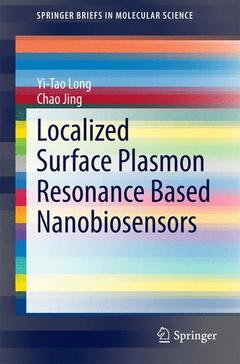Description
Localized Surface Plasmon Resonance Based Nanobiosensors, 2014
SpringerBriefs in Molecular Science Series
Authors: Long Yi-Tao, Jing Chao
Language: English
Subjects for Localized Surface Plasmon Resonance Based Nanobiosensors:
Approximative price 52.74 €
In Print (Delivery period: 15 days).
Add to cart119 p. · 15.5x23.5 cm · Paperback
Description
/li>Contents
/li>Biography
/li>Comment
/li>
This book introduces the fundamentals and applications of the localized surface plasmon resonance (LSPR) property of noble metallic nanoparticles, with an emphasis on the biosensing applications of plasmonic nanoparticles, especially in living cell imaging and photothermal therapy. It provides an overview of the different operating principles of plasmonic sensors, particularly the single-nanoparticle-based detections, and a series of creative biosensors based on the modulation of different parameters of nanoparticles (particle size, shape, composition and surrounding medium) for label-free detection. The interparticle coupling effect, plasmon resonance energy transfer, electron transfer on plasmonics surface are also covered in this book.
This book is intended for graduate students and researchers working in the interdisciplinary field combining chemistry, biology, material science and nanophotonics.
Yi-Tao Long is a Professor at the School of Chemistry and Molecular Engineering, East China University of Science and Technology, China.
Part I Fundamentals of Localized Surface Plasmon Resonance.- Brief Introduction to Localized Surface Plasmon Resonance and Correlative Devices.- Electromagnetics of Metals and Theory Fundamentals.-Part II Sensing Applications of Plasmonic Nanoparticles.- Refractive Index-Based Plasmonic Biosensors.- Morphology- and Composition- Modulated Sensing.- Interparticle Coupling-Enhanced Detection.- Detection Based onPlasmon Resonance Energy Transfer.- Electron Transfer on Plasmonics Surface.- Plasmonic Nanoparticles in Cell Imaging and Photothermal Therapy.- Conclusions and Future Prospects.
Yi-Tao Long received his Ph.D. in bioelectroanalytical chemistry from Nanjing University in 1998. After completing his two-year postdoctoral research at Heidelberg University, Dr. Long moved to Canada, and worked as a research scientist for 5 years at the University of Saskatchewan and the University of Alberta. Then he worked at the Department of Bioengineering, UC Berkeley as a senior research scientist from 2006 to 2007. Since 2008, he has been appointed as a Professor at the School of Chemistry and Molecular Engineering, East China University of Science and Technology (ECUST), China. Dr. Long received the Distinguished Young Scientist Fund from National Natural Science Foundation of China in 2011, and has been elected as a distinguished professor under the Changjiang Scholar Program of Ministry of Education of China since 2012. His research interests include nanospectroscopy, biointerfaces/biointerphases, spectroelectrochemistry, integrated biosensors, and nanopore single-molecule analysis.
Chao Jing graduated with a B.S. degree from ECUST in 2010. She is currently pursuing her Ph.D. in analytical chemistry under the supervision of Prof. Yi-Tao Long. Her research interests include single-nanoparticle spectroelectrochemistry and biosensors.
Introduces the parameters influencing the plasmonic property of nanoparticles such as particle size, shape, composition and surrounding medium
Reviews the applications of plasmonics as nanobiosensors based on dark-field scattering spectroscopy
Focuses on the applications of plasmonic nanoparticles in living cell imaging and photothermal therapy
Includes supplementary material: sn.pub/extras
These books may interest you

Plasmonics in Chemistry and Biology 143.25 €



